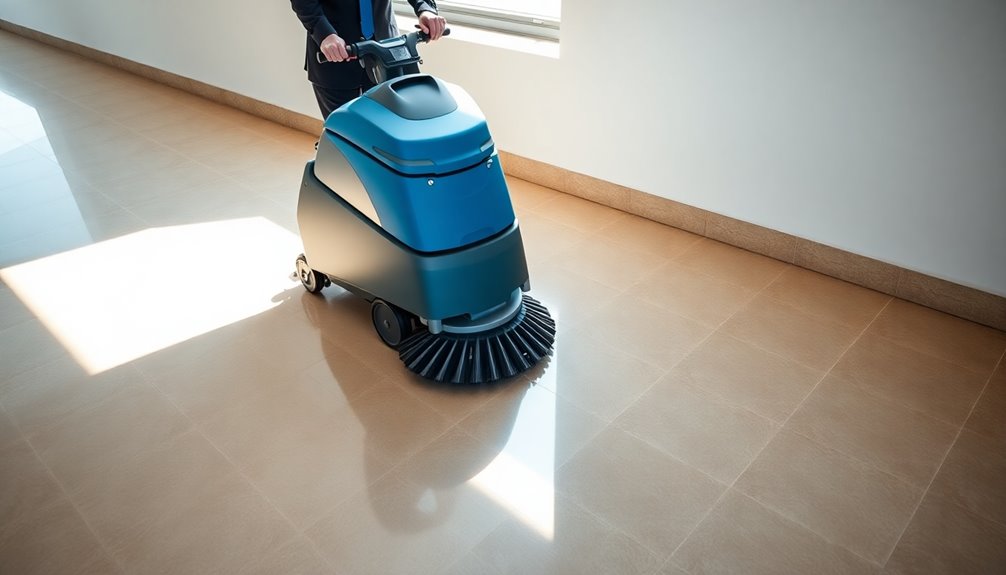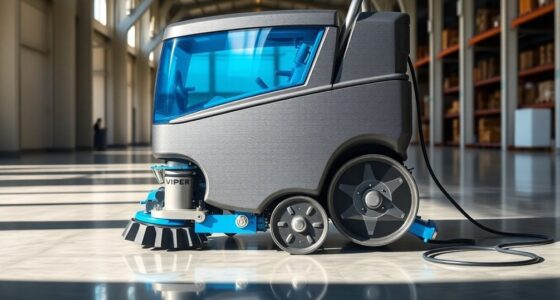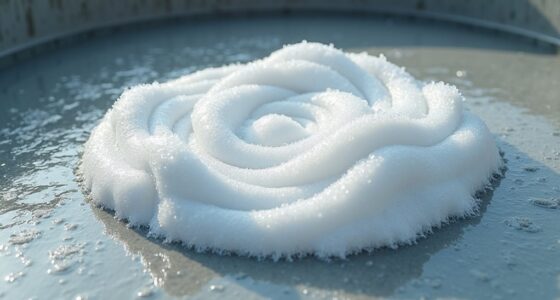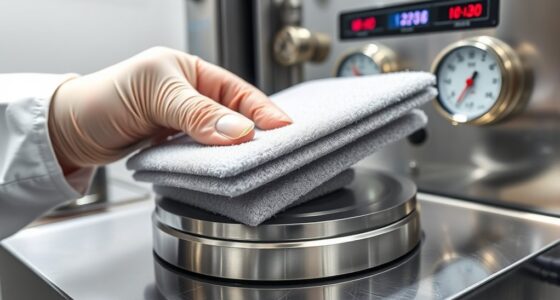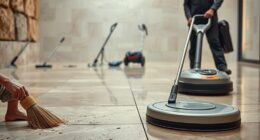To operate a floor scrubber, start by clearing the area of debris and fill the solution tank with water and detergent. Secure the scrubber pad or brush, then turn on the solution flow and vacuum system. Move the scrubber in straight, overlapping rows for effective cleaning. Keep an eye on the solution and recovery tank levels to avoid spills. With these basics in place, there's more to discover about maintaining your scrubber for peak performance.
Key Takeaways
- Clear the area of debris and fill the solution tank with water and detergent according to the manufacturer's instructions.
- Ensure the scrubber pad or brush is securely attached before starting the machine.
- Activate the solution flow and vacuum, then begin cleaning from the farthest corner of the area.
- Move the scrubber in straight, parallel rows, overlapping slightly to ensure complete coverage.
- Regularly check and empty the recovery tank to maintain suction efficiency during operation.
Choosing a Floor Scrubber
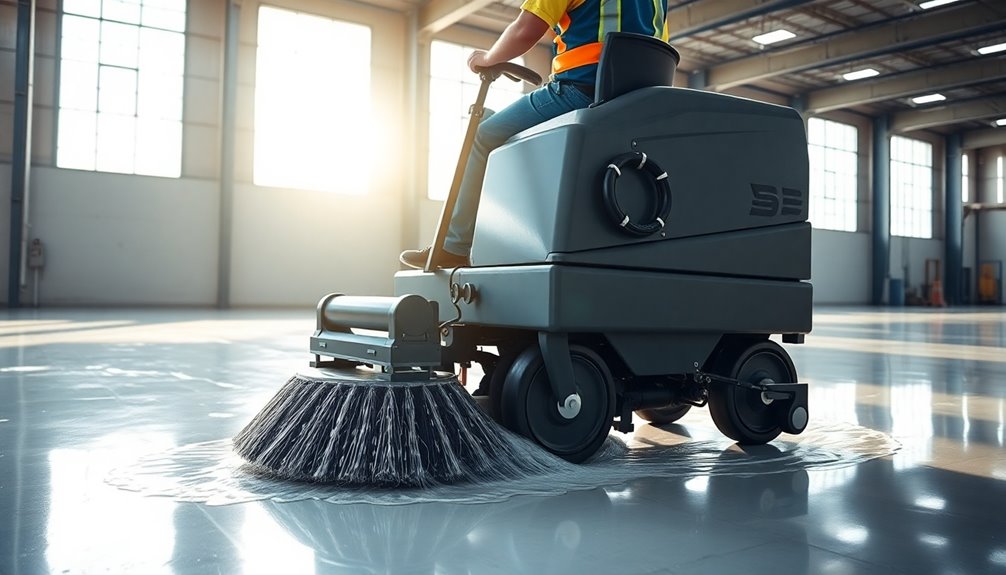
When choosing a floor scrubber, it's important to evaluate the size of your cleaning area. Larger spaces often need more efficient cleaning equipment than traditional mops and buckets.
For moderate-sized floor surfaces, consider walk-behind scrubbers like the Factory Cat Micro-HD, which offer good maneuverability. If your cleaning tasks are lengthy, self-propelled scrubbers can reduce physical effort, making them ideal for extended use.
For extensive areas, a ride-on commercial floor scrubber, such as the PowerBoss Admiral 48, can greatly boost efficiency by allowing you to cover larger spaces quickly.
Always factor in labor costs and your budget to select a machine that meets your operational needs without overspending, while ensuring the recovery tank is adequate for your cleaning tasks.
Getting Started With Your Floor Scrubber
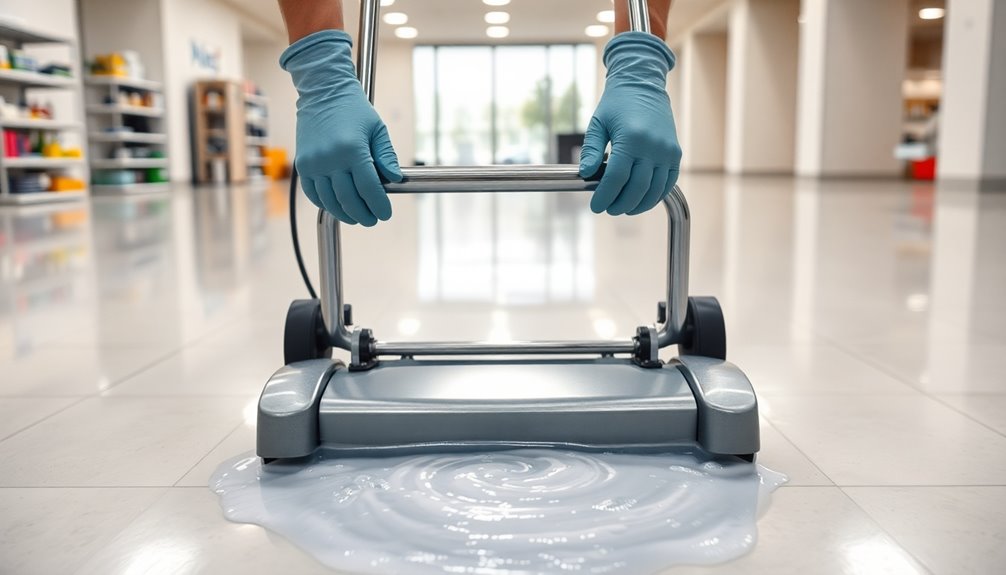
Before you start using your floor scrubber, make sure to clear the area of any loose debris and dirt to enhance cleaning efficiency.
Next, fill the solution tank with water and detergent, following the manufacturer's instructions for the right dilution ratio.
With these steps taken care of, you're ready to get to work!
Prepare the Cleaning Area
To prepare the cleaning area for your floor scrubber, start by removing any loose debris and dirt. This enhances efficiency and helps avoid damage to your machine.
Next, make certain the scrubber pad or brush is securely fastened for effective cleaning. If your scrubber doesn't have an automatic system, activate the solution flow and vacuum system to guarantee proper care during operation.
Begin cleaning from the corner of the area farthest from the door to prevent having to re-clean sections.
After you finish, remember to rinse the recovery tank to eliminate any dirty water, maintaining the scrubber in prime condition for future use.
Proper preparation is key to achieving ideal cleaning results.
Fill Solution Tank Properly
With the cleaning area prepped, it's time to focus on filling the solution tank properly for your floor scrubber.
Start by checking the manufacturer's specifications for the correct water-to-detergent ratio; this guarantees effective cleaning.
Before you fill the solution tank, make certain it's clean and free of any leftover detergent or debris.
If the manufacturer recommends it, use warm clean water to enhance the cleaning solution's effectiveness.
When you fill the solution tank, do so slowly to avoid overfilling and spills, which can hinder your floor care efforts.
Finally, after you've filled it, securely close the solution tank lid to prevent leaks during operation.
Taking care of these steps will help you achieve ideal cleaning results.
Methodology of Cleaning With a Floor Scrubber
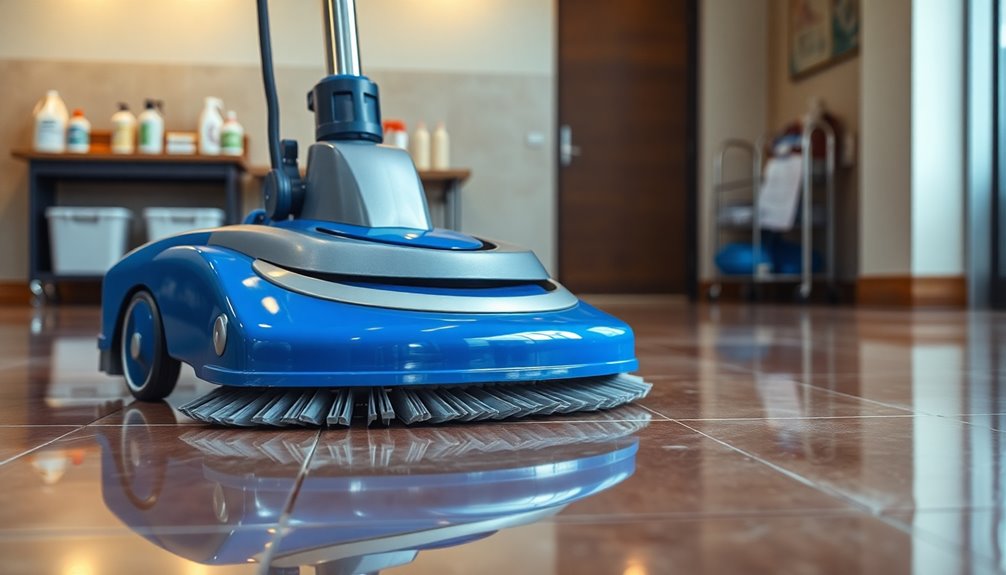
To clean effectively with a floor scrubber, start by moving it in straight, parallel rows, overlapping slightly for even coverage.
While you're at it, keep an eye on the recovery tank and empty it as needed to maintain efficiency.
Adjusting the water flow and brush pressure will also help you achieve the best results for different surfaces.
Cleaning Technique Overview
While operating a floor scrubber, it's essential to maintain a systematic approach for effective cleaning. Follow these cleaning techniques to achieve the best results:
- Operate in straight, parallel rows, overlapping each pass slightly.
- Adjust the water flow level and brush pressure based on the surface type and dirtiness.
- Check the solution tank level regularly, adding water as necessary.
- Monitor the recovery tank thoroughly to prevent spills and maintain suction efficiency.
- After cleaning, plug the unit into its charger to extend battery life.
Monitoring Recovery Tank
Monitoring the recovery tank is essential for maintaining the efficiency of your floor scrubber. Regularly check the tank level during operation to see when it needs to be emptied. If it fills up, it can impact your vacuum system's performance, leading to lost suction power.
Aim to empty the tank when it reaches about 75% full to guarantee peak cleaning efficiency. Always turn off the water pump and vacuum systems before transporting the scrubber to the dumping area to avoid spills.
After use, clean and empty the recovery tank thoroughly to prevent residue buildup that can cause odors and equipment malfunction. By staying vigilant, you'll guarantee your floor scrubber operates at its best.
Managing Excess Foam
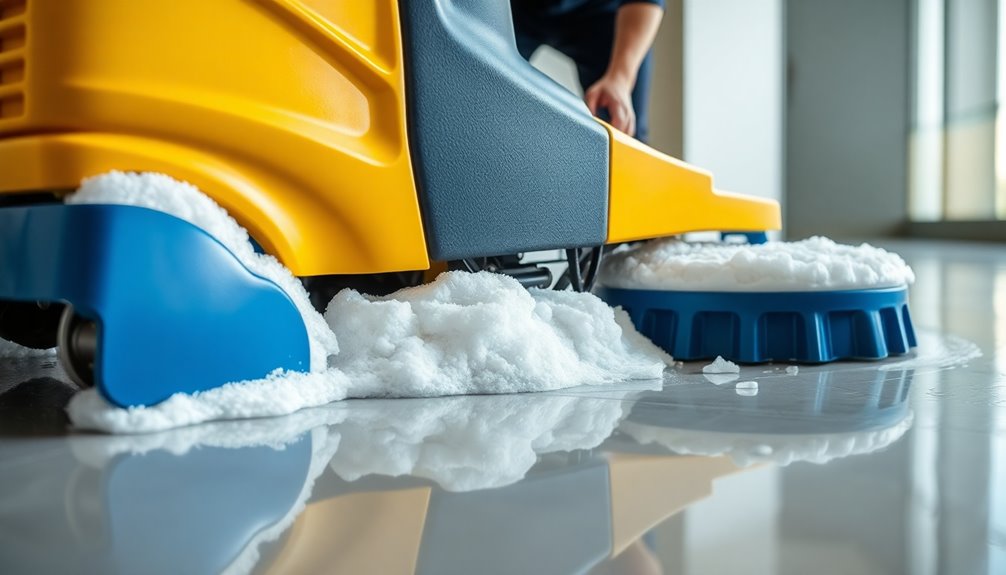
Excess foam can quickly become a nuisance when operating a floor scrubber, so managing it effectively is essential for smooth performance.
Here are some strategies to keep foam under control:
- Always add water first before detergent to minimize foaming in the solution tank.
- Adjust your cleaning strategy since riding scrubbers typically create more foam than walk-behind models.
- Incorporate a de-foaming agent in the recovery tank to prevent foam overflow into the vacuum motor.
- Pre-wash the floor with the suction system disengaged to reduce foam buildup.
- Rinse the recovery tank thoroughly after each use to avoid chemical buildup.
Draining the Recovery and Intake Tanks
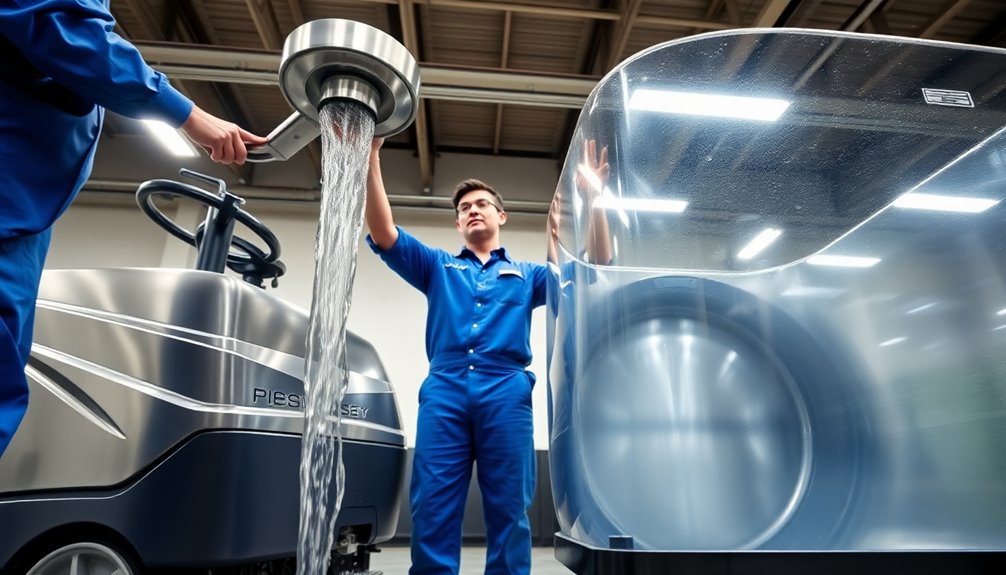
Draining the recovery and intake tanks is an essential step in maintaining your floor scrubber's efficiency.
Regularly monitor the recovery tank level during operation to know when it needs emptying, preventing overflow and maintaining suction efficiency.
Before moving the machine to the dumping area, always turn off the water pump and vacuum systems to avoid accidental spillage.
After each use, clean and empty both tanks to prevent chemical buildup, ensuring peak performance for future cleaning sessions.
When it's time to dispose of dirty water, follow local environmental regulations and the disposal instructions on chemical labels.
Consider the environmental impact of your waste disposal practices and adhere to company protocols for responsible wastewater disposal.
Storing Your Commercial Floor Scrubber
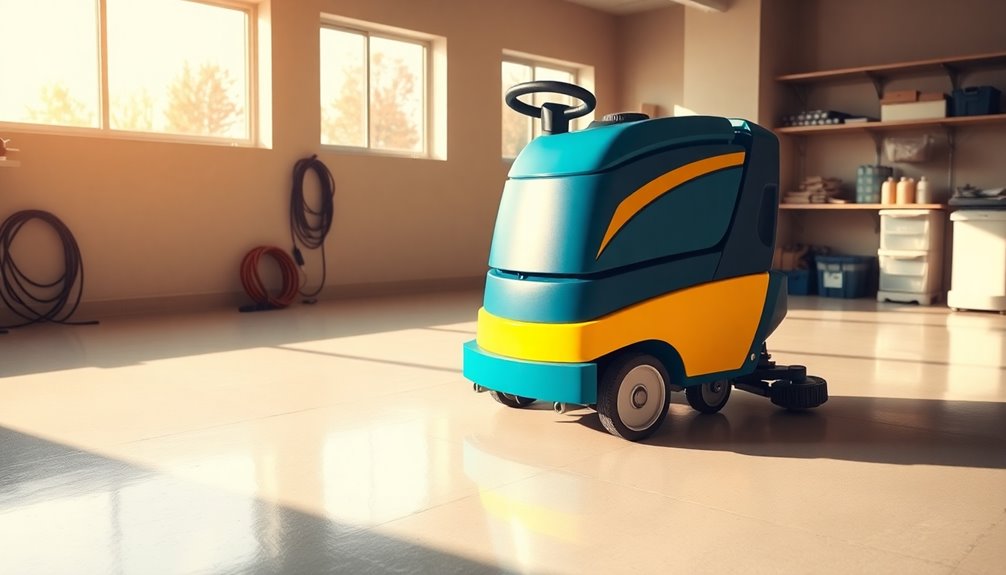
Proper storage of your commercial floor scrubber is essential for extending its lifespan and maintaining peak performance. Follow these steps to effectively store your machine:
- Always keep it in a dry, clean area to prevent moisture damage.
- Unplug the scrubber and neatly wrap the power cord to avoid kinks.
- Remove and clean the pad driver or brush after each use to prevent residue buildup.
- Confirm the solution and recovery tanks are empty and clean to avoid mold growth.
- Store the machine horizontally or vertically with the pad driver removed to prevent warping.
Frequently Asked Questions
How Do You Control a Floor Scrubber?
To control a floor scrubber, you start by ensuring it hovers in place when you turn it on.
You can adjust the handle for side-to-side movement, allowing you to clean edges and corners precisely.
Forwards and backwards movement is achieved by stepping, keeping you balanced.
Make sure to overlap your passes for even coverage, and twist the handle to apply extra pressure on areas that need more scrubbing attention.
This way, you maintain effective control.
How Do You Use a Floor Scrubber Ride?
Using a floor scrubber ride is like steering a ship through a clean ocean.
You start by ensuring the area's clear, just like checking for obstacles at sea. Fill the tank with water and detergent, then begin at the furthest corner, working your way out.
Move in straight lines, adjusting settings for best results. Keep an eye on the recovery tank, and don't forget to plug it in after for the next voyage!
How Does a Walk Behind Floor Scrubber Work?
A walk-behind floor scrubber works by using a motor to power a rotating brush or pad that scrubs the surface while applying cleaning solution.
You guide the scrubber in straight, parallel lines for even coverage. As you scrub, the machine collects dirty water and debris in a recovery tank, allowing for uninterrupted cleaning.
You can adjust the brush pressure and water flow based on the floor type to optimize your cleaning efficiency.
Why Won't My Floor Scrubber Turn On?
If your floor scrubber won't turn on, start by checking the power outlet; it might be faulty.
Look for any damage on the power cord, as kinks can disrupt electrical flow.
Verify the safety switch is engaged, since many machines won't operate without it.
If it's battery-operated, make certain it's charged and connected properly.
Finally, consult the user manual for any specific error codes that might help diagnose the issue.
Conclusion
Operating a floor scrubber can feel as effortless as gliding across a polished dance floor once you get the hang of it. By choosing the right machine and following the steps for cleaning, foam management, and maintenance, you'll keep your floors sparkling and your scrubber in top shape. Remember, regular care and proper storage will extend its life. So, embrace the rhythm of cleaning, and let your floor scrubber do the hard work for you!
